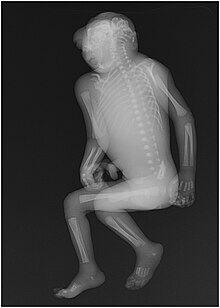Anencefalie
Anencefalie je absence hlavní části mozku, lebky a pokožky hlavy, ke kterému dochází během embryonálního vývoje.[1] Je to porucha, která vyplývá z defektu neurální trubice, který nastane, když se rostrální konec (hlava) neurální trubice neuzavře, většinou mezi 23. a 26. dnem po početí.[2] Dětem narozeným s touto poruchou obvykle chybí telencephala,[3] největší část mozku, skládající se hlavně z mozkových hemisfér, včetně neokortexu, který je zodpovědný za poznání. Zbývající struktura je obvykle pokryta pouze tenkou membránou – kůže, kosti, mozkové pleny, atd. všechny chybí. Až na několik málo výjimek[4] děti s touto poruchou nepřežily déle než pár hodin, případně dnů po narození.
Příznaky
Národní institut neurologických poruch a mozkového infarktu (NINDS) popisuje projevy této poruchy následovně: „dítě narozené s anencefalií je obvykle slepé, hluché, neví o svém okolí a není schopno cítit bolest. I když někteří jedinci s anencefalií se mohou narodit s hlavním mozkovým kmenem, absence funkční mozkové hemisféry trvale vylučuje možnost, že získají povědomí o svém okolí. Reflexivní činnosti, jako je dýchání a reakce na zvuk nebo dotek, se mohou vyskytovat.“
Prognóza
Neexistuje žádný lék nebo standardní léčba pro anencefalii a prognóza je smrt. Většina anencefalických plodů (v 55 % nepřerušených těhotenství) nepřežije porod. Novorozenci, kteří porod přežijí, obvykle umírají během několika hodin nebo dní po porodu na srdeční zástavu.[5][6]
Pouze ve 4 zaznamenaných případech dítě s anencefalií přežilo delší časové úseky. Zatím nejdéle žila Angela Morales z USA, která zemřela v roce 2017 ve věku 3 let a 9 měsíců.
Kvůli své prognóze se novorozenci s anencefalií neresuscitují.
Odkazy
Reference
V tomto článku byl použit překlad textu z článku Anencephaly na anglické Wikipedii.
- ↑ Archivovaná kopie [online]. [cit. 2018-09-01]. Dostupné v archivu pořízeném dne 2008-05-09.
- ↑ [s.l.]: [s.n.] ISBN 0471382256.
- ↑ [s.l.]: [s.n.] ISBN 1850706123.
- ↑ Baby Without A Brain, Nickolas Coke, Update [online]. [cit. 2018-09-01]. Dostupné v archivu pořízeném dne 2012-09-14. (anglicky)
- ↑ Archivovaná kopie [online]. [cit. 2018-09-01]. Dostupné v archivu pořízeném dne 2008-05-09.
- ↑ [s.l.]: [s.n.] ISBN 1-4377-0755-6.
Externí odkazy
 Obrázky, zvuky či videa k tématu Anencefalie na Wikimedia Commons
Obrázky, zvuky či videa k tématu Anencefalie na Wikimedia Commons
Přečtěte si prosím pokyny pro využití článků o zdravotnictví.
Média použitá na této stránce
A side view of the anencephalic fetus shown also in Image:Anencephaly front.jpg
Anencephaly is a fatal neural tube defect in which the cerebral hemispheres do not develop. Typically some brainstem tissue is present, but it is anatomically highly disorganized. Prenatal screening for neural tube defects has significantly decreased the number of births of infants with anencephaly, and correction of folate deficiency (now known to be an etiologic factor) is expected to reduce the incidence even further. It has been recommended that all women of childbearing age take folate supplements to reduce the risk of this devastating anomaly.
With no upper brain development, there is no development of the calvarium. The result is that the eyes and eyelids are the topmost part of the body, giving the head a "frog-eyed" appearance. The side view, shown above, brings to mind some of the depictions of people and gods in Pre-Columbian Mesoamerican art. One could idly speculate that these early artists were inspired by sporadic anencephalic births among their people.Autor: Lucien Monfils, Licence: CC BY-SA 3.0
X-ray of a stillborn child with anencephaly, a neural tube defect where the brain and top of skull do not form.
Star of life, blue version. Represents the Rod of Asclepius, with a snake around it, on a 6-branch star shaped as the cross of 3 thick 3:1 rectangles.
Design:
The logo is basically unicolor, most often a slate or medium blue, but this design uses a slightly lighter shade of blue for the outer outline of the cross, and the outlines of the rod and of the snake. The background is transparent (but the star includes a small inner plain white outline). This makes this image usable and visible on any background, including blue. The light shade of color for the outlines makes the form more visible at smaller resolutions, so that the image can easily be used as an icon.
This SVG file was manually created to specify alignments, to use only integers at the core 192x192 size, to get smooth curves on connection points (without any angle), to make a perfect logo centered in a exact square, to use a more precise geometry for the star and to use slate blue color with slightly lighter outlines on the cross, the rod and snake.
Finally, the SVG file is clean and contains no unnecessary XML elements or attributes, CSS styles or transforms that are usually added silently by common SVG editors (like Sodipodi or Inkscape) and that just pollute the final document, so it just needs the core SVG elements for the rendering. This is why its file size is so small.



